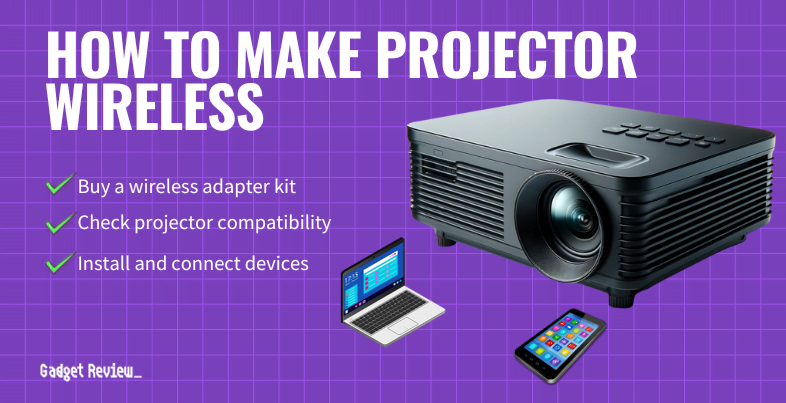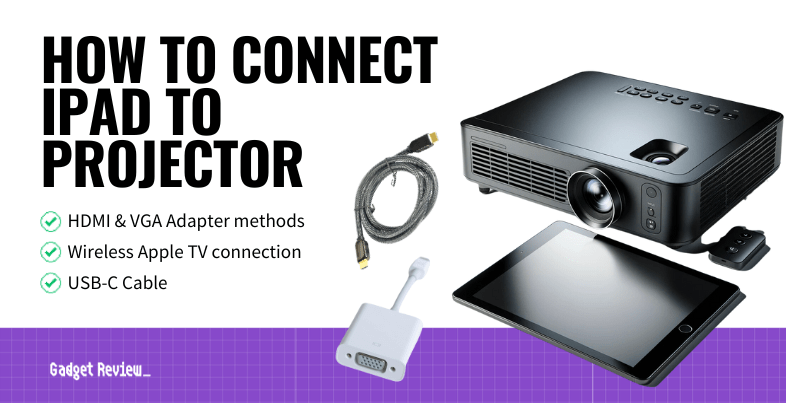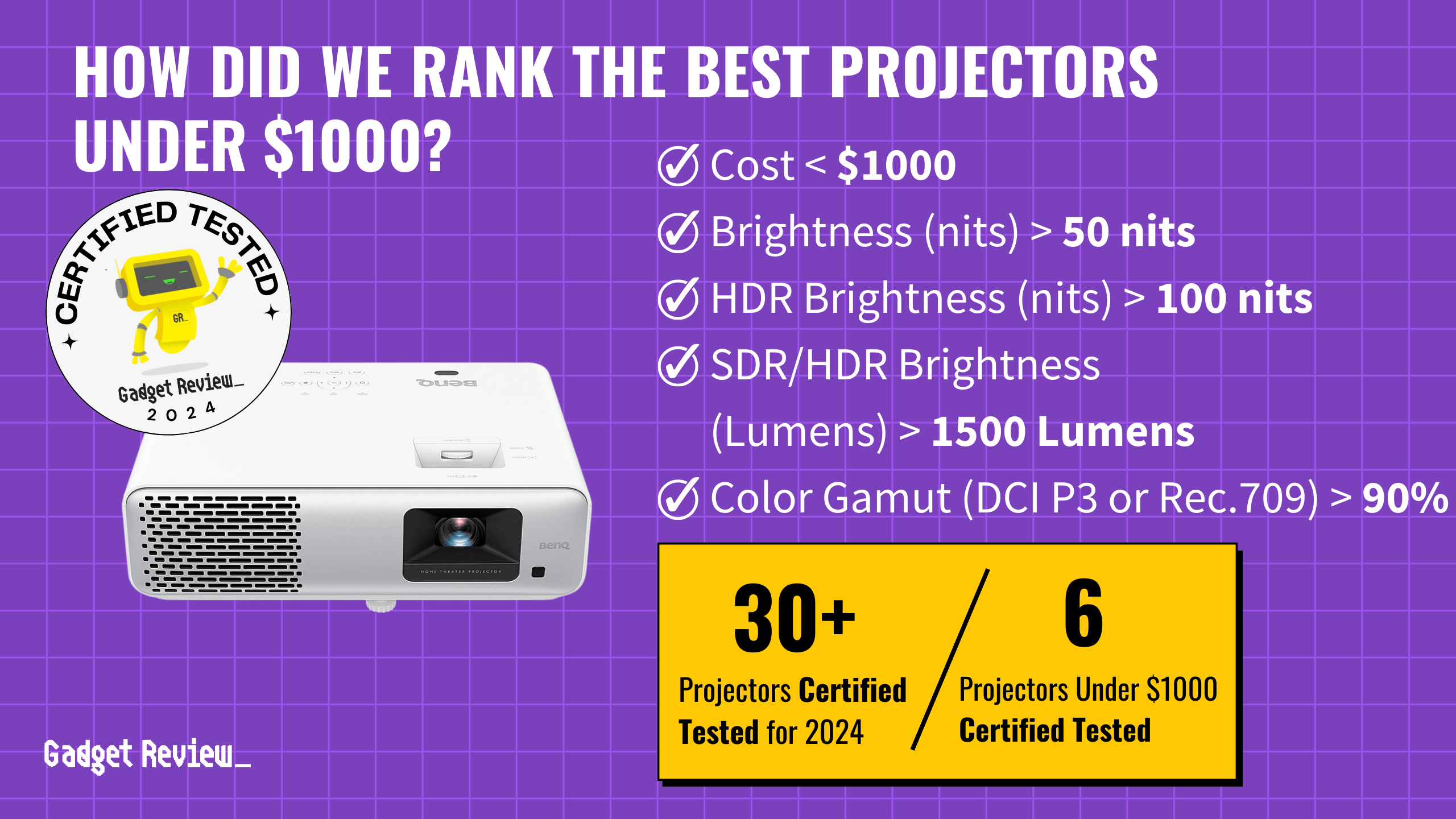To find the best projector screen, we started by buying the top 15 models on the market and researched them with our own eyes using our favorite games and movies. During our research, we paid special attention to features like color accuracy, gain, ease of installation, and different surface materials. We took this research and narrowed our list down to the best projector screens. With one of the best projector screens, it should be easily set up in your living room. Take a look at the best projectors to use with your new projector screen.
Jump To: Compare the features of the top Projector Screens.
During our research, we were impressed with each screen’s ability to display stellar picture quality, but in the end, we chose the Silver Ticket 100″ projector screen as our winner and #1 pick. Its super affordable price, tensioned rod system, and ability to display the best picture possible made it an easy pick for us. Keep reading to learn more about this projector screen and the others we thought were good enough to make the cut.
Top 3 Home Theater Projector Screens
[table id=330 responsive=scroll /]#1 Silver Ticket 100″ Projector Screen
Award: Editor’s Choice
Price: $189.98 | Features: Tensioned rod straightening system, 1:1 gain, 160° viewing angle, 100″ white screen
WHY IT’S A TOP PICK: For mid-range projector owners, the Silver Ticket 100″ is your “ticket” to a beautiful home theater experience.
For the budding home theater enthusiast who doesn’t want to drop half a house payment on their next projector screen, the Silver Ticket 100″ provides a nice balance of premium features at a cost that won’t leave you out an arm and a leg by the time you hobble away from the checkout counter. Its viewing area is 100” diagonal x 87” wide x 49” high.
Related: If you’re looking for a projector to watch your favorite sports, check out the best projector for sports.
With a 1:1 high gain screen for bright images in ambient light, a 16:9 image aspect ratio, and a super simple setup process, the Silver Ticket is perfect for larger home theaters and living rooms. Step-by-step instructions and videos make assembly effortless. Plus, it helps that this projector is easy to put together. Whether you’re running one of the best short-throw projectors or the top long-throw projector, as long as you’ve got the space to spare, a 100″ quality screen looks good from almost any distance, and the white screen surface is perfect for your home cinema. Plus, thanks to the vinyl screen material, your media’s colors will really be able to shine in ways you never thought possible before. For more options on a budget, try the best cheap projector.
#2 Elite Screens ezFrame Series 120 Projector
Award: Best Projector Screen for Gaming
Price: $1198.49 | Features: CineGray 5D screen material, 4K Ultra HD ready, 1:1.5 gain
WHY IT’S A TOP PICK: The Elite Screens ezFrame Series 120″ offers peak projector screen performance.
There are cost-effective projection screens, there are quality-built projector screens, and then there’s the cream-of-the-crop Elite Screens ezFrame Series 120″, a 4K projector screen that stands in a category all of its own. Fully-tensioned screen, acutely honed and tuned to CineGray 5D standards, 16:9 HD format aspect ratio, and complete with Ambient Light Rejecting technology, this is the absolute best projector screen you can get under $1,000 on shelves today. It uses a diffusion layer over a reflective layer so that light from the projector reflects squarely onto the viewer while the outer layer absorbs indirect light to enhance image quality. Its viewing area is 120” diagonal x 104” wide x 58” high. This will give you a quality at-home viewing experience in a way that doesn’t break the bank. You can also get this in CineWhite or CineGray screens 3D, and the ezFrame 2 Rear Series has rear projection screen material so the projector can be placed behind the screen.
Elite Screens continues to be one of the best in the business when it comes to providing quality products that meet the standards set by other projector manufacturers. So whether you plan on using your personal theater for a movie night, sports entertainment, or video games, there isn’t another model out there that can stand toe-to-toe with everything the ezFrame can do with both hands tied behind its velvety-black back, and sturdy 6pc aluminum frame. It comes with a 2-year warranty.
#3 SUPER DEAL 120” Projector Screen
Award: Best Budget Projector Screen
Price: $68.99 | Features: 91.3″ x 89.8″ white material viewing space, manual pulldown, non-tensioned
WHY IT’S A TOP PICK: No-muss, no-fuss performance at a price that’s too good to pass up.
Sometimes, products don’t make it onto our list because they’re objectively the highest quality, but simply because you can’t beat their insanely low price. The “Best Choice Products Manual Projector Screen” may not have a flashy name or the best features on the block, but it’s still a great choice if you have a low-tier projector setup and don’t mind a few wrinkles around the furthest edges of the screen. Still, it has a high-quality display, with the 1:1 high gain screen/aspect ratio and black border allowing for a high-resolution display, ideal for TV marathons and slideshows. The 1:1 aspect ratio on this widescreen projector is a turnoff for most, but this can actually be adjusted using a friction-based locking mechanism to watch 16:9 content. If you have ever seen picture quality without the standard aspect ratio of 16:9. Pair it with the best quiet projector for a calm movie evening, or use the leading outdoor projector for a drive-in movie feel with your new screen.
See also: Projectors don’t have to run you a lot of money. Take a look at the best projector under 1000 to see what we mean.
By no means is the Best Choice Products Manual Projector Screen the best choice if you have a projector that inches over the $1,000 mark, but for anyone who’s in the starter market and wants to dip their toes into home theater bliss without diving in full-force, this $52.99 pick ticks off all the minimum requirements with a no-muss, no-fuss setup and decent color reproduction all around.
Mistakes to Avoid
Going too big/small for your setup: While it may seem obvious, you’d be surprised how many people forget to actually measure the space they plan to mount their projector movie screen on before making a purchase. This is an important step, because you may not know what to use for a projector screen yet, but your space setup should be top of mind. Set up your projector where you think it will fit, and then display the image against the proposed mounting wall. This is the same setup you’ll use if you’re installing an outdoor screen.
Measure how big the image can go at its maximum width/length, and then once you have that locked in, buy a screen size that fits the display size at its widest point. If you end up with a space that’s the wrong size, the picture quality from the projector will suffer. Projectors range from as small as 4:3 to 16:19 and larger. Following this guide should make it possible to find a projector for your home that fits your needs.
Not buying mounting brackets: One mistake that many first-time projector screen buyers make (including yours truly) is thinking that the screen they buy is a package deal, complete with everything you’ll need to get up and running right out of the box. While some choices on this list come with brackets designed to help you mount the screen onto your wall, others may need a separate kit to get everything set up properly. Be sure to check and see if your screen comes with brackets first, and if not, throw them into the cart alongside the unit you want.
Ignoring viewing angles: Just like regular HDTV displays, the viewing angle on a projector screen can differ wildly depending on quality, performance, and price. Having a wide viewing angle is also important. If you can’t see the screen from various angles, it makes for an uncomfortable experience. Optimally, you want to look for a screen that has anywhere from an 80° – 160° viewing angle like this, since they will be the best for large living rooms with more than a few seating locations that wrap around the screen rather than one couch that stares at it dead-on. Before purchasing your screen, make sure to sit in the space where you’ll be viewing content. Take a look and see if you have the angles set up for a projector screen, and room for all of the projector setup. If your room has the space for wide viewing, this would be something to consider when purchasing your projector. You can also consider one of the top-rated ceiling-mounted projectors if you don’t have space to put your projector on a table.
Best Projector Screen Features to Look Out For
Color Accuracy/Gain
- Perhaps one of (if not the most) important factors you should consider before picking up your next projector screen is how accurately it reproduces the colors shone out by your companion projector.
- Though you might not realize it just by looking at pictures of them online, the color profile of all projector screens is not created alike. In fact, the best projector screen for a home theater will have great contrast and brightness ratings.
- Without getting bogged down in the technical details of what makes a good color gamut, all you need to know is that the screen gain of a solid screen is “1:1”, which refers to how much light the screen reflects when compared to a uniform reflecting surface known as a “Lambertian surface.” It’s important to consider the gain screen as well when considering the quality of a projector’s brightness. When looking at the best projector for your home, it is also important to consider the aspect ratio. This all contributes to good projection quality with a brighter image and accurate colors.
Electric or Pull-Down?
- Another choice you’ll have to make when selecting your next projection screen is whether or not you want to drop the extra coin on an electrically powered screen that moves on its own or one you’ll have to pull down manually instead. Electric models, also called motorized screens, use an electric motor and can be raised and lowered with a remote control. Also, installing these motorized screens involves a little more work because you will need a power supply for the electric motor.
- In general, electric screens cost about twice as much as their manual counterparts due to the extra parts required in their manufacturing process. Still, some are very affordable if you’re after more inexpensive screens, like the Elite Screens Spectrum 2 Electric Motorized Projector Screen. Keep in mind where you’ll be installing and using this screen, especially if you’re planning on using it as an outdoor projector screen with your theater projector for outdoor movie nights.

- Electric screens or motorized screens also have the added benefit of giving your home entertainment setup that “professional movie theater” feel when they slowly descend from the ceiling instead of pull-down screens, but this is all personal preference, of course.
- Is it easy to maintain? You’ll want to select a screen you can effectively maintain, provided you know how to clean a projector screen the right way. Otherwise, you risk mounting a screen that you can’t clean.
- Therefore, if you do opt for a retractable screen, you’ll definitely want to know how to fix a retractable projector screen.
Tensioned vs. Non-Tensioned
- If you can spring for it, you should almost always go for a “tensioned” screen over a non-tensioned screen.
- This feature refers to a set of wires embedded along both edges of the projection screen, and are pulled taught to prevent the screen from getting those “wavy lines” that can form over time.
- If you want a fully flat image and plan on keeping your projector setup around for a year or more, spending a little extra on a tensioned setup is the way to go. It’s important to consider the build quality when thinking of a projector that is going to work for your home long term. You may want to also consider a motorized projector screen for your home.
- Moreover, if your non-tensioned screen begins to get wrinkles, you’ll want to know how to get wrinkles out of a projector screen.
Which Best Projector Screen Is Right for You
Ultimately, the best projector screen that’s going to be right for you will depend on how much budget you’ve leftover to spend after you’ve purchased your new projector, speakers, and receiver to complete your new home theater. Image quality is important, but it’s possible to find a high-quality projector that won’t break the bank. It’s also important to consider a projector screen that is easy to set up too. And, if you’ve had any damage to your screen, you can use our guide on how to repair a projector screen to fix it.
You’ll find many screen types with large angles, including inflatable, portable, and retractable screens. The type of projector screen you want depends on your immediate needs. If you have to travel frequently for work purposes which involve a portable projector, try to invest in a portable projector screen. If you need to use a room for multiple purposes like as a teacher for example, the ideal screen might be a retractable one so you can use a whiteboard behind the projector screen. Projector screens tend to come in a variety of sizes, so make sure the size of the projection surface suits your space along with your projector’s throw distance.
If you have a lot to splurge on and demand the highest quality for the upcoming 4K Blu-Ray revolution that’s waiting just over the horizon, the EliteScreens ezFrame Series will be the pick for you. Conversely, if you’re going for the mid-range level of quality, you can’t go wrong with the Silver Ticket, and for the budget home theater connoisseur, there’s always the Best Choice Products Manual 119″ to round out our annual lineup. Though the reasonable price of cheaper screens might be tempting, the high-quality material of an expensive projector screen could be a worthwhile investment that can last you longer if you use the screen frequently.





















